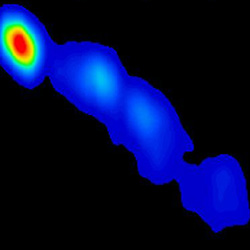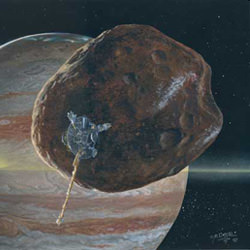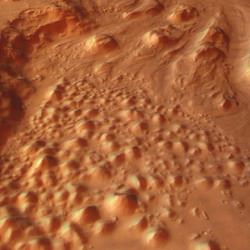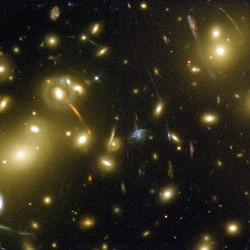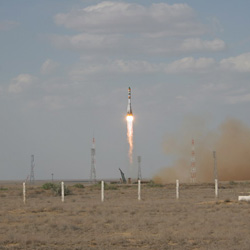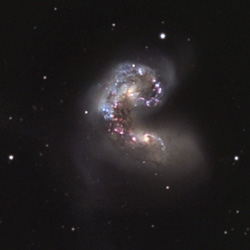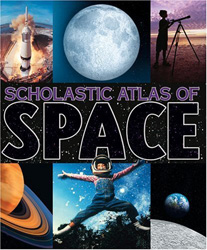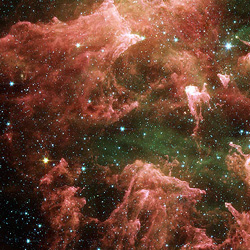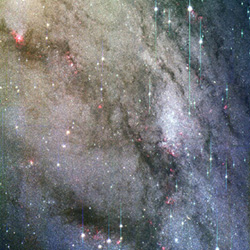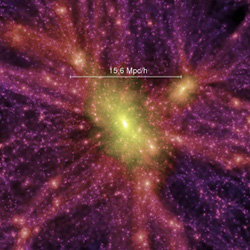
Simulated image that shows the distribution of matter in the Universe. Image credit: MPG. Click to enlarge.
The Virgo consortium, an international group of astrophysicists from the UK, Germany, Japan, Canada and the USA has today (June 2nd) released first results from the largest and most realistic simulation ever of the growth of cosmic structure and the formation of galaxies and quasars. In a paper published in Nature, the Virgo Consortium shows how comparing such simulated data to large observational surveys can reveal the physical processes underlying the build-up of real galaxies and black holes.
The “Millennium Simulation” employed more than 10 billion particles of matter to trace the evolution of the matter distribution in a cubic region of the Universe over 2 billion light-years on a side. It kept the principal supercomputer at the Max Planck Society’s Supercomputing Centre in Garching, Germany occupied for more than a month. By applying sophisticated modelling techniques to the 25 Terabytes (25 million Megabytes) of stored output, Virgo scientists are able to recreate evolutionary histories for the approximately 20 million galaxies which populate this enormous volume and for the supermassive black holes occasionally seen as quasars at their hearts.
Telescopes sensitive to microwaves have been able to image the Universe directly when it was only 400,000 years old. The only structure at that time was weak ripples in an otherwise uniform sea of matter and radiation. Gravitationally driven evolution later turned these ripples into the enormously rich structure we see today. It is this growth which the Millennium Simulation is designed to follow, with the twin goals of checking that this new paradigm for cosmic evolution is indeed consistent with what we see, and of exploring the complex physics which gave rise to galaxies and their central black holes.
Recent advances in cosmology demonstrate that about 70 percent of our Universe currently consists of Dark Energy, a mysterious force field which is causing it to expand ever more rapidly. About one quarter apparently consists of Cold Dark Matter, a new kind of elementary particle not yet directly detected on Earth. Only about 5 percent is made out of the ordinary atomic matter with which we are familiar, most of that consisting of hydrogen and helium. All these components are treated in the Millennium Simulation.
In their Nature article, the Virgo scientists use the Millennium Simulation to study the early growth of black holes. The Sloan Digital Sky Survey (SDSS) has discovered a number of very distant and very bright quasars which appear to host black holes at least a billion times more massive than the Sun at a time when the Universe was less than a tenth its present age.
“Many astronomers thought this impossible to reconcile with the gradual growth of structure predicted by the standard picture”, says Dr Volker Springel (Max Planck Institute for Astrophysics, Garching) the leader of the Millennium project and the first author of the article, “Yet, when we tried out our galaxy and quasar formation modelling we found that a few massive black holes do form early enough to account for these very rare SDSS quasars. Their galaxy hosts first appear in the Millennium data when the Universe is only a few hundred million years old, and by the present day they have become the most massive galaxies at the centres of the biggest galaxy clusters.”
For Prof Carlos Frenk (Institute for Computational Cosmology, University of Durham) the head of Virgo in the UK, the most interesting aspect of the preliminary results is the fact that the Millennium Simulation demonstrates for the first time that the characteristic patterns imprinted on the matter distribution at early epochs and visible directly in the microwave maps, should still be present and should be detectable in the observed distribution of galaxies. “If we can measure the baryon wiggles sufficiently well”, says Prof Frenk, “then they will provide us with a standard measuring rod to characterise the geometry and expansion history of the universe and so to learn about the nature of the Dark Energy.”
“These simulations produce staggering images and represent a significant milestone in our understanding of how the early Universe took shape.” said PPARC’s Chief Executive, Prof Richard Wade. “The Millennium Simulation is a brilliant example of the interaction between theory and experiment in astronomy as the latest observations of astronomical objects can be used to test the predictions of theoretical models of the Universe’s history.”
The most interesting and far-reaching applications of the Millennium Simulation are still to come according to Prof Simon White (Max Planck Institute for Astrophysics) who heads Virgo efforts in Germany. “New observational campaigns are providing us with information of unprecedented precision about the properties of galaxies, black holes and the large-scale structure of our Universe,” he notes. “Our ability to predict the consequences of our theories must reach a matching level of precision if we are to use these surveys effectively to learn about the origin and nature of our world. The Millennium Simulation is a unique tool for this. Our biggest challenge now is to make its power available to astronomers everywhere so that they can insert their own galaxy and quasar formation modelling in order to interpret their own observational surveys.”
Original Source: PPARC News Release

